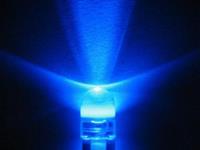Italian researchers combine theory and practice to develop better blue LEDs; a step towards a flatter future for technology.
Francesco Lelj, Mauro Ghedini and colleagues at Universita della Bastilicata and Universita della Calabria, Italy, have perfected the recipe for better small-molecule aluminium complexes which emit light in the blue region of the spectrum.

The promise of using organic light emitting diodes, OLEDs, for flat full-colour displays has led researchers to design better small molecules whose luminescence can be tuned. Out of the three primary colours (blue, green and red), blue is the hardest colour of emission to achieve but all are vital in the development of organic flat screens.
Some progress has been achieved by moving from using aluminium compounds with ligands based on quinoline alone to those that also contain phenol derivatives. However the reasons why these new complexes are stable and efficient blue emitters have been unclear up to now. Lelj has used the combined tools of theory and spectroscopy to study all the possible contributing factors fully.
It was thought that changing the substituents and changing the electronic profile of the quinolate ligand attached to the aluminium would allow tuning of the colour of light. However Lelj has shown that a far greater effect is due to the crystal packing of the complex in the solid phase as this increases the intensity of emission within the blue region of the spectrum.
Blue OLED fabrication has now been demystified and better flat displays are one step closer.
Suzanne J Abbott
References
M La Deda, I Aiello, A Grisolia, M Ghedini, M Amati, and F Lelj, Dalton Trans., (DOI: 10.1039/<MAN>b510463g</MAN>)






No comments yet